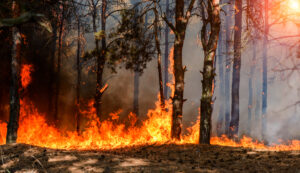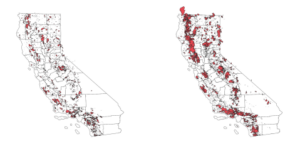
Article by Derik Suria & Meghna Pamula
Air pollution is a serious public health concern. Research shows significant disparities in exposure to air pollution and health outcomes among different communities by the level of income. Low-income communities are likely to be disproportionately affected by air pollution (Harvard study). African Americans and Latinos are more likely to suffer from respiratory diseases caused by air pollution, because they are more likely to live near sources of pollution, such as highways and industrial facilities (American Lung Association, 2023). This correlation occurs because air quality is an amenity that is capitalized into housing prices; cleaner air is among the many goods purchased by more affluent households in California. But that is changing because wildfire smoke is not as localized as pollution from factories and freeways and wildfires are on the rise.
Over the past five decades, fires in California have increased in frequency, severity, early onset and duration. Between 1972 and 2018, the number of large wildfires in California increased by 784 percent, and the area burned increased by more than 1,200 percent (Environmental Market Solutions Laboratory, UC Santa Barbara). The map below shows an upward trend in the number of fires and total area burned. Among the factors which have contributed to the increasing frequency and intensity of wildfires in California are climate change, drought, and human activity (Markkula Center for Applied Ethics, Santa Clara University). The 2018 Camp Fire, which destroyed the town of Paradise and claimed 85 lives, was one of the deadliest and most destructive wildfires occurring in recent years.
 California wildfires, 1980-2000 and 2001-2020
California wildfires, 1980-2000 and 2001-2020
Source: California Fire Perimeters (1898-2020) dataset by Conservation Biology Institute.
This increase in forest fires makes it more difficult for the affluent to purchase clean air. Using pollution data from the Environmental Protection Agency and income data from the American Community Survey (ACS), we look to see whether the association between income and air pollution has lessened between 2006 and 2020.
We focus on PM2.5, or particulate matter 2.5, an air pollutant containing tiny particles able to reach the lungs and adversely affect health (New York Department of Health). We use census tracts by counties as the unit of analysis.
We find that a 10 percent increase in household income is associated with a decrease in the level of PM2.5 by 0.15 in the period 2006-2010. As the average air quality in 2006-2010 is 10.95, this is roughly a 1.4 percent decline in exposure. But this coefficient declines to 0.13 in 2011-2015 and 0.09 for 2016-2020. This suggests that income as a determinant of air pollution has gradually weakened over time in California. These findings support our supposition that while the rich may prefer to move to places with better air quality, the rise in forest fires has made geographic segregation by income less relevant to air quality.
While we include county fixed effects to account for county-specific time-invariant unobservable characteristics, we do not explicitly analyze the relationship between ethnicity and pollution within counties the way we have for income. Redlining policies have influenced how racial groups are distributed in California, leading minorities to occupy less desirable land even after controlling for income. While it seems likely that forest fire pollution does not discriminate by race any more than it does by income, it is possible that lands currently inhabited by racial minorities are more vulnerable to this form of pollution. What will be the market response if cleaner air can no longer be reliably purchased? This will likely be a modest force for home price equalization and possibly a slight easing of one driver of neighborhood segregation.
